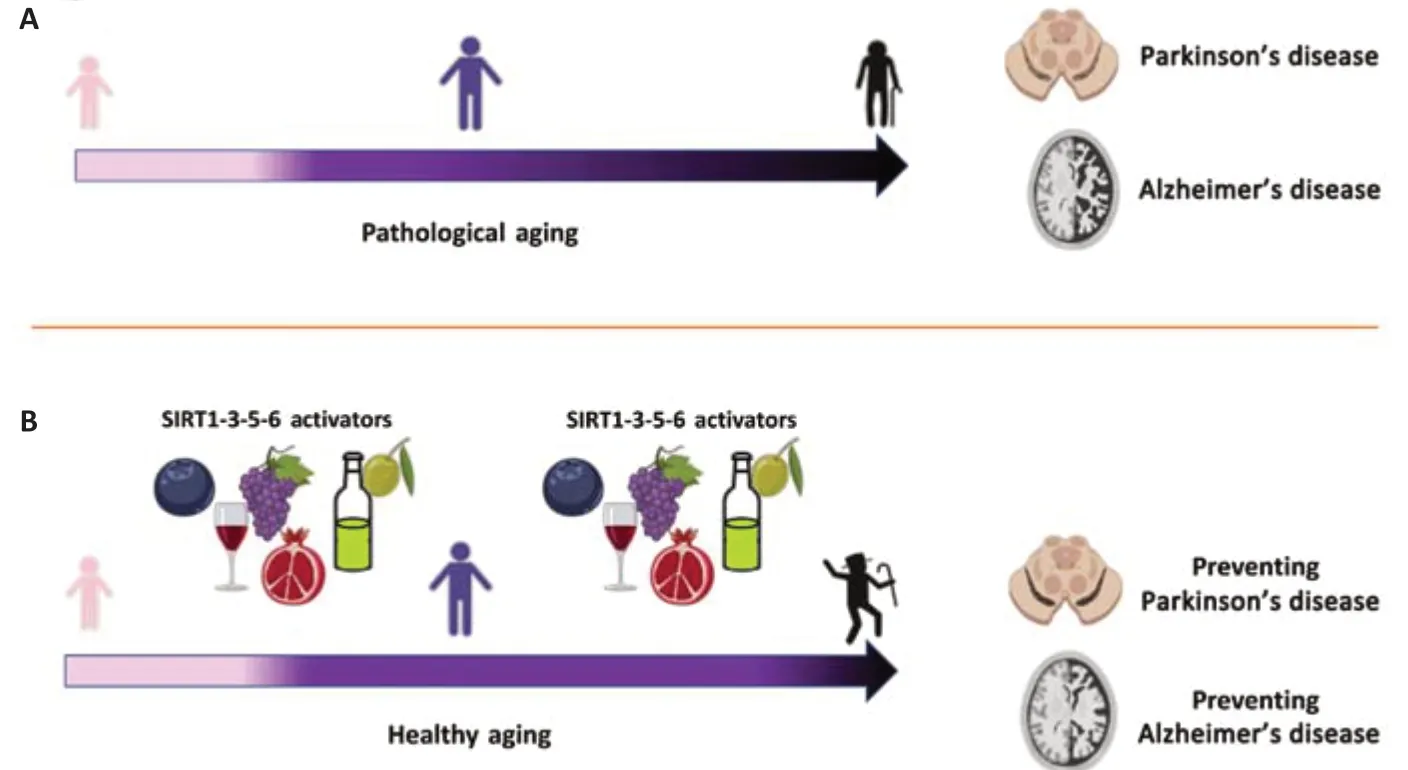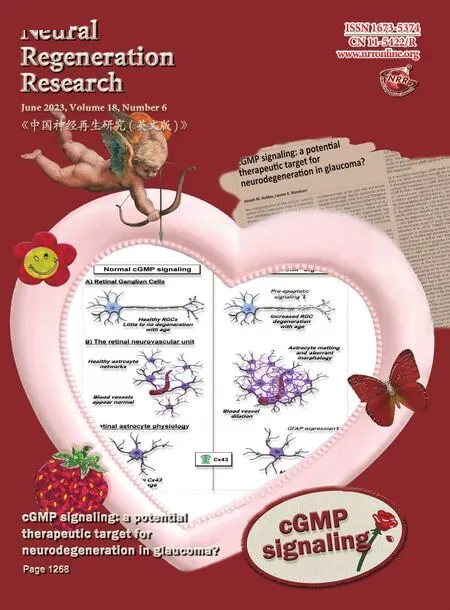Nature can still be the strongest help against aging and neurodegeneration: the sirtuins way
David Della-Morte,Francesca Pacifici
Unfortunately,aging is not a reversible phenomenon and the processes of senescence are unavoidable.However,the biological effects of aging may be turned back,and with those,it can be reduced risk of all age-related illnesses,such as cardiovascular diseases,cancer,diabetes,and neurodegenerative diseases,including Alzheimer’s disease (AD),and Parkinson’s diseases(PD).In the latest decades,scientists worldwide therefore have developed several strategies,either natural or pharmacological,to counteract aging phenomena,with the final goal to improve human life expectancy.The main scientific rationale beyond these strategies focuses on the opportunity to reduce chronic low-grade inflammation (inflammaging),the increase in oxidative stress damage,and the impairment in the immune system,all typical mechanisms of senescence (Verdaguer et al.,2012).Then,most innovative anti-aging treatments are mainly based on pharmacological senolytic therapeutics,plasma membrane redox system activators,epigenetic modulators,and stem cell therapies(Verdaguer et al.,2012).More specifically,novel therapies against AD include humanized monoclonal antibodies,such as bapineuzumab and solanezumab,targeting senile plaques(Rygiel,2016);and those against PD include new pharmaceutical compounds,such as Neu 120,and V1512,EPI-589,targeting neurological central motor system (Zhong et al.,2022).
Mammalian aging is the most significant and independent risk factor for all chronic diseases since biological systems change with age.For this reason,one of the last and most important NIH missions is “to seek fundamental knowledge about the nature and behavior of living systems and the application of that knowledge to enhance health,lengthen life,and reduce illness and disability.”PD has multifactorial etiologies triggered by genetic and/or environmental factors (Zhong et al.,2022).The pathological processes leading to PD begin many years before motor symptom manifestation (Zhong et al.,2022).The damage and degeneration of dopaminergic neurons in the substantia nigra result from inflammatory factors,and reactive oxygen species production,and typical mechanisms of aging linked with mitochondrial dysfunctions (Zhong et al.,2022).The mitochondrial respiratory chain is markedly impaired in the substantia nigra in PD patients and various animal models of PD,which is strongly related to impairment in mitochondrial sirtuins’(SIRT) pathways (He et al.,2022).
This evidence is of particular importance,since mitochondrial SIRT pathways and SIRT,in general,have been fully recognized as the main genes/proteins regulating the mechanisms of aging and related chronic diseases.Sirtuins 1–7 (SIRT1-7) in mammals belong to a family of histone deacetylases that are ubiquitously expressed in different tissues (Palmirotta et al.,2016).SIRT possess NAD+-dependent deacetylase activity and are implicated in many cellular processes such as cell cycle regulation,fatty acid metabolism,gene transcription,and cellular stress response(Palmirotta et al.,2016).SIRT1 is the most studied sirtuin protein and its tissue expression is regulated by caloric restriction and physical activity.SIRT1 plays a pivotal role in regulating senescence and has an antiaging effect by reducing inflammation and oxidative stress.SIRT2 mainly controls cell cycle and its activation significantly delays cell cycle progression.SIRT3,SIRT4,and SIRT5 are mitochondrial SIRT with beneficial effects due to their abilities in deacetylates and activate mitochondrial enzymes involved in fatty acid β-oxidation,amino acid metabolism,electron transport chain,and antioxidant defenses.SIRT5 catalyzes ammonia to urea and reduces the production of oxidative stress with a cellular protective effect.SIRT6 controls genomic DNA stability and repair,which plays a pivotal role in maintaining organ integrity against aging.SIRT7 is the only one localized in the nucleolus that acts as a component of the RNA polymerase I transcriptional machinery (Palmirotta et al.,2016).
Despite these positive evidences on SIRT,some controversial data concerning their ability to regulate aging processes are present.In fact,both SIRT3 and SIRT5 decrease oxidative stress blunting aging,while SIRT4 increases oxidative stress (Ji et al.,2022).In line with this finding,by using a model of Caenorhabditis elegans,we found that knock-out of mitochondrial sirtuinsir-2.3,homologous to mammalian SIRT4,was protective of both chemical ischemia and hyperactive channel induced necrosis (Sangaletti et al.,2017).Controversial and contrasting data have also been reported for SIRT2: the modulation of SIRT2 expression and activity is associated with processes involved in PD pathogenesis (Liu et al.,2019);moreover,its increased expression is also correlated with aging-related neurodegenerative disorders,highlighting an harmful effect of SIRT2(Liu et al.,2019).
However,mitochondrial SIRTs neuroprotective effects against PD by regulating mitochondrial bioenergetics and reducing reactive oxygen species production,neuroinflammation,and autophagy.Moreover,activation of nuclear and cytoplasmatic SIRT1 can reduce abnormal α-synuclein aggregation in cells,which is the other main pathogenesis of PD (Li et al.,2020).Difference in protein levels in post-mortem brains of PD patients and the impact of genetic variants of sirt1 on the risk for PD further corroborate this evidence (Li et al.,2020).In agreement with the aforementioned SIRT,SIRT6 showed preventive role against neurodegenerative disorder (in particular AD),and anti-aging activity (Jung et al.,2016).
Based on all these findings,SIRT activators have been suggested for the treatment of PD and other neurodegenerative diseases (Figure 1).Synthetic sirtuin-activating compounds,including SRT1720,SRT2014,and SRT3025,have been then designed whit the final goal to increase SIRT’ activation in medical use,but their role on PD and many other chronic illnesses need to be still explored and we are far to use them in clinical practice (Li et al.,2020).Instead,resveratrol,a most powerful natural activator of SIRT1,has been found to reduce damage and toxic effects of oxidative stress and α-synuclein aggregationin vitroand to prevent the loss of dopaminergic neurons in a mouse model of PD (Li et al.,2020).However,despite these data regarding the neuroprotective effects of resveratrol against PD,there are still some controversies over whether it could be used as an effective pharmacotherapy due to its low bioavailability.Resveratrol derivatives are natural compounds that are stable and available with similar effects as resveratrol (Arbo et al.,2020).Among those,polydatin is a glycosylated derivative that has been demonstrated to protect against PD in several rodent models (Arbo et al.,2020).Accordingly,a methoxylated derivate of resveratrol,pterostilbene,exerts an antiinflammatory and neuroprotective effect in AD models (Arbo et al.,2020).Besides resveratrol,the lignan polyphenol honokiol and the flavonoid 2′,3′,4′-trihydroxyflavone have also been shown to prevent α-synuclein formation (Jovcevski et al.,2020).In addition,ellagic acid can attenuate α-synuclein toxicity by preventing cell aggregation and improving cell viability by restoring autophagy and suppressing apoptosis in anin vitromodel of PD (Ardah et al.,2021).

Figure 1|Beneficial effects of natural compounds.
Recently,we tested the potential neuroprotective effect of a natural patented compound,known as A5+,by using anin vitromodel of PD induced by 6-hydroxydopamine (6-OHDA) in murine neuroblastoma cell line N1E115 (Pacifici et al.,2022).A5+is composed of ellagic acid (20%),polydatin (98%),pterostilbene (20%),and honokiol(20%),mixed with recommended doses of zinc,selenium,and chromium.After pre-treating the cells with 10 μM A5+for 48 hours and then with 6-OHDA plus A5+for further 24 hours,we found that:
1.A5+protects against 6-OHDA-induced neuroinflammation by significantly reducing the levels of pro-inflammatory cytokines,such as interferon-γ,interleukin-6,tumor necrosis factor-α,and CXCL1.
2.A5+protects against 6-OHDA-induced apoptotic death by decreasing PARP-1 cleavage and levels of TNFRI,DR6,caspase-8,Fas,and Hsp70 involved in PD-related apoptosis,especially in the death receptor pathway.
3.A5+reduces reactive oxygen species production via ERK1/2 activation,a pivotal pathway to regulate oxidative stress.
4.A5+promotes N1E115 differentiation into dopaminergic neurons,as indicated by the levels of tyrosine hydroxylase,a well-established dopaminergic neuronal marker.
These evidences support that other natural compounds present on A5+,like zinc and selenium,also help in the synergic and integrative effects of its components that act in different phases of cellular savage mechanisms.Therefore,we demonstrated the efficacy of this natural polyphenols’ mixture against PD in anin vitromodel.
Interestingly,we also found that the same natural mixture could protect against influenza A virus and severe acute respiratory syndrome coronavirus 2,specifically by reducing interleukin-6 levels after viral infection (De Angelis et al.,2021).We also are submitting no published data regarding the ability of A5+to activate the main SIRT,like SIRT1-3-5-6.
Sirtuins are the most important longevity genes that are highly conserved.Their activities,at multiple cellular levels allow modulating many processes as respiration,apoptosis,and inflammation.The adaptation of humanity,across different eras,was,most probably through savage mechanisms that manly used natural products(micronutrients) able to activate beneficial pathways and then to preserve our organs,like the brain,from damage,such as accumulation of misfolded proteins.Polyphenols in high quantity are present in several fruits,vegetables,and plants,similarly to the minerals we tested against PD.The modern lifestyle,especially in western countries,is characterized by poor behaviors,like unhealthy diet,sedentary,smoking,all factors that decrease the natural defenses,like SIRT activity,and increase the risk for degenerative diseases.Novel research technologies may allow us to really better understand the impact of risk factors and savage pathways on these mechanisms.Today,by using Organ-on-a-Chip applications,by combining microfluidics technology with machine learning it would be possible to test the effect of natural mixture in different systems for pre-clinical studies(Filippi et al.,2022).
Therefore,as demonstrated by a total natural compound tested in a model of PD,the strongest strategy to prevent neurodegeneration and/or any kind of chronic diseases may go back to the natural protection-proposing a good combination of diet and physical activity during the earlymiddle stage of our life.Of course,medications are life-saving,and we should continuously focus on developing better therapies against any kind of chronic diseases until they have no more chronic side effects.Nature creates diversity and we just need to preserve and respect it.It is the mother of all things and any plan to potentiate it will make us stronger.
This work was supported in part by The Evelyn F.McKnight Brain Institute.
David Della-Morte*,Francesca Pacifici
Department of Systems Medicine,University of Rome “Tor Vergata”,Rome,Italy (Della-Morte D,Pacifici F)
Department of Human Sciences and Quality of Life Promotion,San Raffaele Roma Open University,IRCCS San Raffaele Roma,Rome,Italy(Della-Morte D)
Department of Neurology and Evelyn F.McKnight Brain Institute,Miller School of Medicine,University of Miami,Miami,FL,USA(Della-Morte D)
*Correspondence to:David Della-Morte,MD,ddellamorte@med.miami.edu.
https://orcid.org/0000-0002-4054-5318(David Della-Morte)
Date of submission:June 27,2022
Date of decision:September 28,2022
Date of acceptance:October 12,2022
Date of web publication:November 18,2022
https://doi.org/10.4103/1673-5374.360173
How to cite this article:Della-Morte D,Pacifici F(2023) Nature can still be the strongest help against aging and neurodegeneration: the sirtuins way.Neural Regen Res 18(6):1271-1272.
Availability of data and materials:All data generated or analyzed during this study are included in this published article and its supplementary information files.
Open access statement:This is an open access journal,and articles are distributed under the terms of the Creative Commons AttributionNonCommercial-ShareAlike 4.0 License,which allows others to remix,tweak,and buildupon the work non-commercially,as long as appropriate credit is given and the new creations are licensed under the identical terms.
Open peer reviewer:Ramu Manjula,Yale University School of Medicine Pharmacology,USA.
Additional file:Open peer review report 1.
- 中国神经再生研究(英文版)的其它文章
- Neuro faces of beneficial T cells: essential in brain,impaired in aging and neurological diseases,and activated functionally by neurotransmitters and neuropeptides
- Profiling neuroprotective potential of trehalose in animal models of neurodegenerative diseases:a systematic review
- Cdk5 and aberrant cell cycle activation at the core of neurodegeneration
- Recent advancements in noninvasive brain modulation for individuals with autism spectrum disorder
- Vicious cycle of lipid peroxidation and iron accumulation in neurodegeneration
- Cell-based therapeutic strategies for treatment of spinocerebellar ataxias: an update

